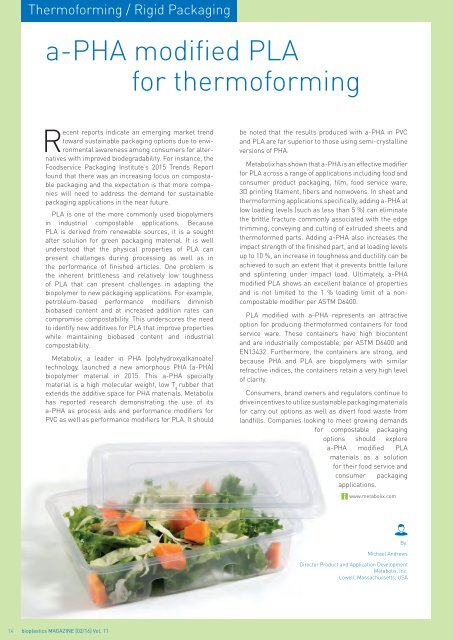Issue 02/2016
bioplasticsMAGAZINE_1602
bioplasticsMAGAZINE_1602
You also want an ePaper? Increase the reach of your titles
YUMPU automatically turns print PDFs into web optimized ePapers that Google loves.
Thermoforming / Rigid Packaging<br />
a-PHA modified PLA<br />
for thermoforming<br />
Recent reports indicate an emerging market trend<br />
toward sustainable packaging options due to environmental<br />
awareness among consumers for alternatives<br />
with improved biodegradability. For instance, the<br />
Foodservice Packaging Institute’s 2015 Trends Report<br />
found that there was an increasing focus on compostable<br />
packaging and the expectation is that more companies<br />
will need to address the demand for sustainable<br />
packaging applications in the near future.<br />
PLA is one of the more commonly used biopolymers<br />
in industrial compostable applications. Because<br />
PLA is derived from renewable sources, it is a sought<br />
after solution for green packaging material. It is well<br />
understood that the physical properties of PLA can<br />
present challenges during processing as well as in<br />
the performance of finished articles. One problem is<br />
the inherent brittleness and relatively low toughness<br />
of PLA that can present challenges in adapting the<br />
biopolymer to new packaging applications. For example,<br />
petroleum-based performance modifiers diminish<br />
biobased content and at increased addition rates can<br />
compromise compostability. This underscores the need<br />
to identify new additives for PLA that improve properties<br />
while maintaining biobased content and industrial<br />
compostability.<br />
Metabolix, a leader in PHA (polyhydroxyalkanoate)<br />
technology, launched a new amorphous PHA (a-PHA)<br />
biopolymer material in 2015. This a-PHA specialty<br />
material is a high molecular weight, low T g<br />
rubber that<br />
extends the additive space for PHA materials. Metabolix<br />
has reported research demonstrating the use of its<br />
a-PHA as process aids and performance modifiers for<br />
PVC as well as performance modifiers for PLA. It should<br />
be noted that the results produced with a-PHA in PVC<br />
and PLA are far superior to those using semi-crystalline<br />
versions of PHA.<br />
Metabolix has shown that a-PHA is an effective modifier<br />
for PLA across a range of applications including food and<br />
consumer product packaging, film, food service ware,<br />
3D printing filament, fibers and nonwovens. In sheet and<br />
thermoforming applications specifically, adding a-PHA at<br />
low loading levels (such as less than 5 %) can eliminate<br />
the brittle fracture commonly associated with the edge<br />
trimming, conveying and cutting of extruded sheets and<br />
thermoformed parts. Adding a-PHA also increases the<br />
impact strength of the finished part, and at loading levels<br />
up to 10 %, an increase in toughness and ductility can be<br />
achieved to such an extent that it prevents brittle failure<br />
and splintering under impact load. Ultimately, a-PHA<br />
modified PLA shows an excellent balance of properties<br />
and is not limited to the 1 % loading limit of a noncompostable<br />
modifier per ASTM D6400.<br />
PLA modified with a-PHA represents an attractive<br />
option for producing thermoformed containers for food<br />
service ware. These containers have high biocontent<br />
and are industrially compostable, per ASTM D6400 and<br />
EN13432. Furthermore, the containers are strong, and<br />
because PHA and PLA are biopolymers with similar<br />
refractive indices, the containers retain a very high level<br />
of clarity.<br />
Consumers, brand owners and regulators continue to<br />
drive incentives to utilize sustainable packaging materials<br />
for carry out options as well as divert food waste from<br />
landfills. Companies looking to meet growing demands<br />
for compostable packaging<br />
options should explore<br />
a-PHA modified PLA<br />
materials as a solution<br />
for their food service and<br />
consumer packaging<br />
applications.<br />
www.metabolix.com<br />
By:<br />
Michael Andrews<br />
Director Product and Application Development<br />
Metabolix, Inc.<br />
Lowell, Massachussetts, USA<br />
14 bioplastics MAGAZINE [<strong>02</strong>/16] Vol. 11


















